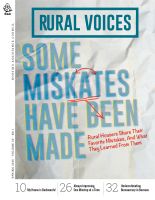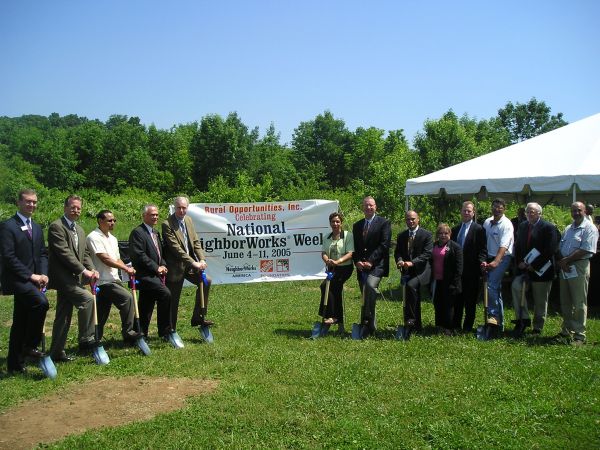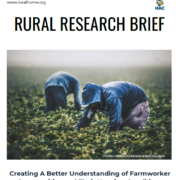 This story appears in the 2015 Spring Edition of Rural Voices
This story appears in the 2015 Spring Edition of Rural Voices
PathStone stayed the course through a ten-year predevelopment process and emerged a stronger real estate developer.
by John Wiltse
Adams County, Pennsylvania, is famous for the Gettysburg battlefields but less well-known outside the immediate vicinity as a major fruit-growing region with a large migrant and seasonal farmworker population. Since 1978, PathStone Corporation, based in Rochester, NY, has been providing critical housing and human services to Adams County farmworkers.
PathStone provided technical assistance to the Adams County Housing Authority for the development of the 12-unit McIntosh Court Apartments, the first off-farm labor housing community in Pennsylvania, which was completed in 1989. We also administered an on-farm housing rehab program in Adams and Berks Counties and developed several other multifamily projects which served both farmworkers and other low income families in the area.
In 1995, buoyed by the successful completion of the first USDA Section 514/516 farm labor housing projects in New Jersey, New York, Ohio and Pennsylvania, PathStone began pre-development work for Jonathan Court. The development is the first-ever Federally funded off-farm migrant housing complex in PathStone’s service area, located down the road from McIntosh Court among the peach and apple orchards of south central Pennsylvania.
This organization was managed by volunteers with no paid staff and no housing development experience whatsoever.
At the time, PathStone was under contract with USDA Rural Development (RD) to provide technical assistance to other non-profits to assist them in developing farm labor housing projects. We secured a commitment from a local faith-based organization, Fruitbelt Ministries, to serve as sponsor/owner of the project, and we helped them modify their organizational structure to conform to the “broad-based membership organization” structure required by RD at the time. This organization was managed by volunteers with no paid staff and no housing development experience whatsoever.
First Lesson Learned: Don’t Try This At Home!
PathStone learned through this and a farmworker housing project located in New Jersey that the development and ownership of a multi-family housing complex is best left to organizations with paid staff trained (or at least in training) to undertake these responsibilities and with affordable housing as a central part of their organizational history and mission.
In the case of the Jonathan Court project, PathStone wound up taking over development of the project due to changes in priorities for Fruitbelt Ministries. In a similar situation in New Jersey, PathStone staff became the de facto staff for the volunteer-run nonprofit membership organization we established to own the first and only 514/516 project in that state.
Our lessons learned here are that change can come very slowly.
The project site for Jonathan Court was an assemblage of three lots, plus two additional parcels with existing family apartments. The existing apartments were going to be part of the project initially, but were later excluded from the deal. There was public water and sewer available and a building boom was going on in the area, so the landowner had no interest in signing our proposed option agreement. After several months of fruitless negotiations, Fruitbelt Ministries borrowed $136,000 from a national nonprofit organization through their revolving loan fund and bought the land. The lender insisted that PathStone guarantee the loan, so it’s not hard to see how we wound up in the driver’s seat on this deal!

For the next eight years or so, this project proceeded down a long and winding development path. PathStone had four different Pennsylvania housing directors over this period and inconsistent project management direction from the Rochester headquarters. The Pennsylvania State Executive Director provided skilled leadership for all PathStone human service programs in the state in addition to housing development, but did not have specific real estate development training or expertise.
Second Lesson Learned:
Make sure housing development staff are directed and supported by experienced housing developers and provide consistent supervision and training, especially through key staff transitions.
Immediately after purchasing the site, we started to receive monthly bills for reservation of sewer capacity from the Possum Valley Sewage Authority. The lack of as-of-right sewer access was overlooked in the due diligence process and wound up adding about $120,000 to the project cost. Another expensive lesson learned!
Getting through the local approvals process proved to be more involved than anticipated, stretching out over two years. Each time we thought we were close to securing the necessary approvals, the local planning board would come forward with a new requirement, report or study that needed to be completed, each of which required the expenditure of additional time and money. We erred in not getting the full scope of the planning board review requirements up front, in writing (though some of these requirements did, in fact, change during the pre-development process).
Working with RD was also challenging, to say the least. RD interpretations of the design guidelines and requirements changed several times during the protracted pre-development stage, necessitating at least three sets of architectural drawings and many months
of additional architectural and engineering work.
In October 1998, the USDA multi-family housing statute was amended to allow owners of off-farm migrant housing projects financed under its Labor Housing Program (Section 514/516) to use RD Rental Assistance funds to provide an annual operating assistance grant to the project (instead of providing individual rental assistance to each household). PathStone decided to take advantage of this new opportunity and the operating budget was revised to show the projected operating assistance in lieu of traditional RA.
In June 2003, five years after the operating assistance change was made to the statute, the National Office of RD finally released a Proposed Rule for the implementation of this change. Although the operating assistance mechanism was put into place by several RD-financed migrant projects in other states, RD in Pennsylvania was unable to process our requests for this subsidy funding.

As of this writing, PathStone has amassed operating deficits of over $300,000 from Jonathan Court over the past 10 years and RD has yet to release any operating assistance. Thankfully, RD staff have recently joined in negotiations with PathStone and we hope
to have a resolution to the past due operating assistance by the time this is printed. Our lessons learned here are that change can come very slowly. at RD and that each RD State Office operates with a high degree of autonomy. PathStone had been aware of both of these facts, but Jonathan Court put a very painful price tag on these lessons!
The Good News:
The 14 apartments in the Jonathan Court project have continued to provide decent, safe housing for hundreds of farmworkers and their families over the past 10 years. The housing is operated in close coordination with the PathStone farmworker services office just down the road and our residents are often enrolled in job training programs and are receiving other supportive services. Their children are often served by the Migrant Head Start Center also operated by PathStone.
Which Brings Us to One Final Lesson Learned:
Include supportive services staff on the development team from the beginning.
Our farmworker service staff just down the road from the site could have been much more involved in the project throughout the process if they had been fully engaged by the real estate development staff.
We have been able to carry the operating deficit as a receivable on our books all these years with advances from our unrelated property management reserves. We have made many changes to the way we manage the development of multi-family housing as a result of the mistakes made on Jonathan Court but, as any experienced developer will tell you, every deal presents a fresh set of challenges and opportunities to learn from new mistakes. Our real estate developers in each state now report to the Senior VP for Housing in Rochester and are supported by a strong internal team. The PathStone Asset Management Committee (composed of the President & CEO, CFO, Senior VP for Housing and Senior VP for Property Management) also provides a level of oversight of our development projects that wasn’t in place for Jonathan Court.
John Wiltse is the Senior Operations Director at PathStone Corporation in Rochester, New York. John cut his teeth on rural community development work at the Cranks Creek Survival Center in Harlan County, KY, as a college intern and has worked in the field for 24 years with PathStone.





